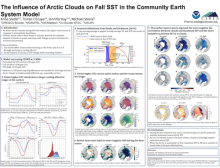The Influence of Arctic Clouds on Annual Maximum SST in the Community Earth System Model
Anne
Sledd
University of Colorado Boulder CIRES/NOAA PSL
Poster
As Arctic sea ice is lost, more open ocean is exposed for longer periods of time, and energy that would have gone towards melting sea ice can instead warm the upper ocean. Arctic sea surface temperatures are sensitive to the surface energy budget, and the surface energy is sensitive to clouds. However, the possible influence of clouds on SST in the Arctic has received little attention. This work uses global climate model experiments with satellite simulators under variable CO2 to investigate how clouds impact annual maximum SST in the Arctic. Under all CO2 concentrations, clouds have a strong cooling effect during summer when incoming solar radiation is at its peak. However, the timing of sea ice retreat determines whether this cooling influences SST maxima. In the pre-industrial climate, when sea ice retreat was limited and occurred late in the melt season, clouds had little impact on annual maximum SST variability. As sea ice retreats earlier with rising CO2, more solar radiation is available to warm the ocean and clouds can play a greater role in reducing this warming. Consequently, under present-day CO2 concentrations, clouds explain 13% more maximum annual SST variability than in the pre-industrial climate. When CO2 is quadrupled relative to pre-industrial levels, the Arctic becomes seasonally ice-free and maximum annual SST are three times more sensitive to summer clouds. While this work uses global climate model simulations, it suggests that clouds are already more important to Arctic SST and will continue to grow in their relevance.

sledd-anne-polar-poster_0.pdf
(4.47 MB)
